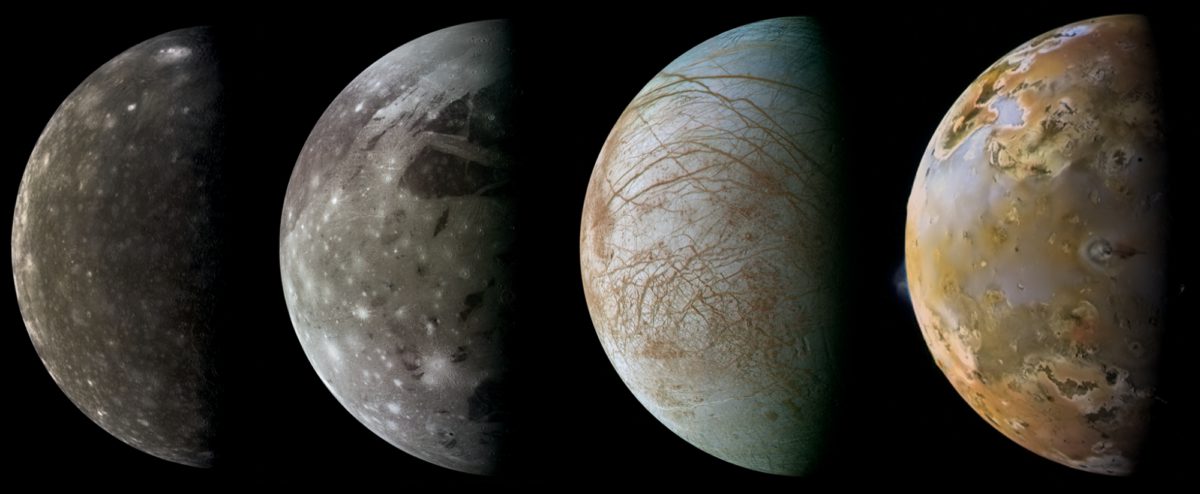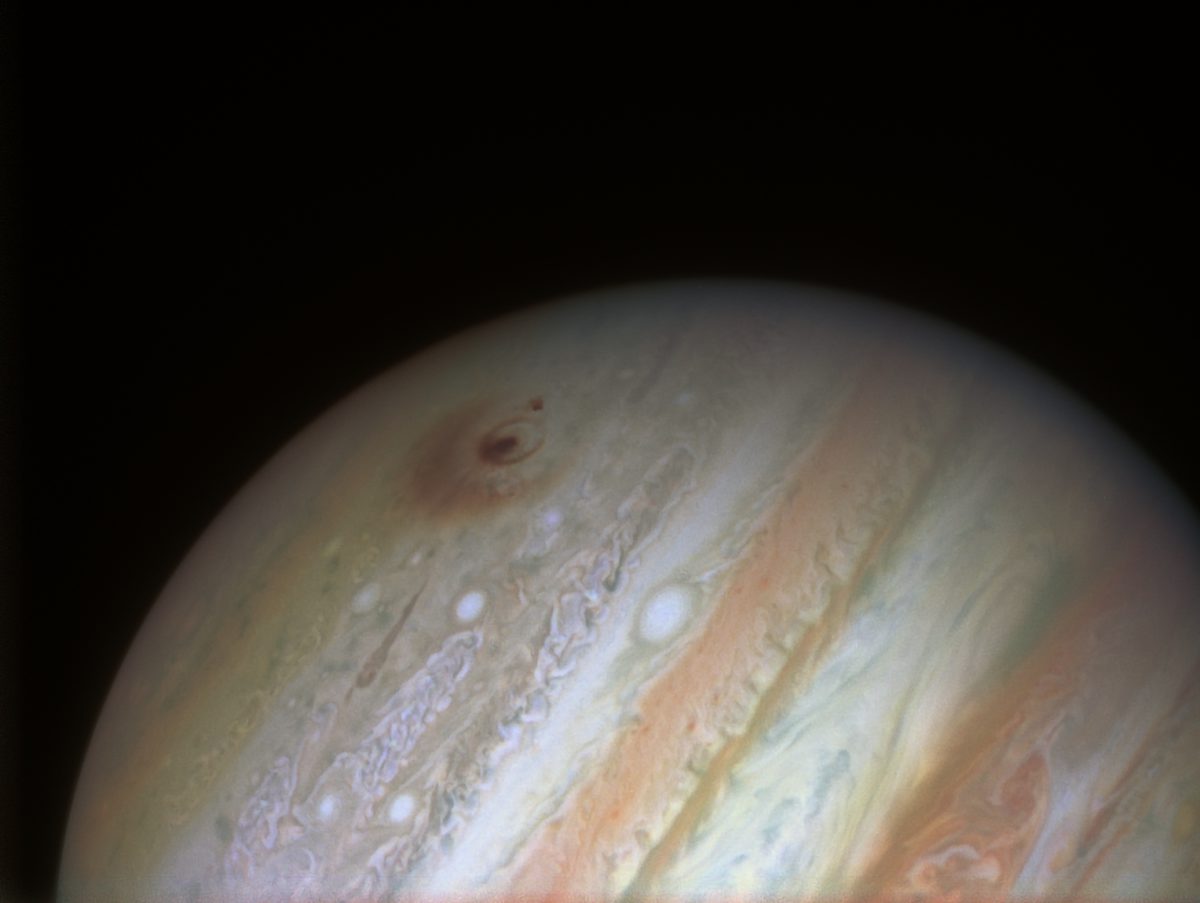Jupiter, the planet with a planetary system of its own
Highlights
- Jupiter, the fifth planet from the Sun, is twice as massive as every other object in our Solar System combined (except the Sun).
- Jupiter's four planet-like moons have features like volcanoes and subsurface oceans, making Jupiter a miniature planetary system of its own.
- By studying Jupiter we learn more about how planetary systems evolve.
Why we study Jupiter
Named after the king of the gods in Roman mythology, Jupiter is a stunning sight to behold. Its red, orange, and yellow swirls, spots, and bands are visible even from small backyard telescopes. Astronomers have observed the planet’s Great Red Spot, a raging storm larger than Earth, for at least 200 years.
Jupiter was the first planet in our Solar System to form. It was probably born much closer to the Sun before migrating to its current position about four billion years ago, scattering asteroids and comets with its gravity in the process. Some of those asteroids and comets slammed into early Earth, possibly bringing water here in the process — the key ingredient for life as we know it.
Many of the exoplanets — planets in other star systems — that we have discovered are Jupiter-like worlds close to their stars, reinforcing the idea that our own Solar System’s large planets have moved from their original positions. By studying Jupiter and comparing it to similar exoplanets, we learn how planetary systems evolve and the possibilities for life elsewhere.
Jupiter has a faint ring system and at least 79 moons, four of which are active, planet-like worlds ranging in size from just smaller than Earth’s Moon to larger than Mercury. Three of those four likely have liquid-water oceans under their surfaces, making them possible havens for life. Europa’s ocean in particular may be one of the most biologically promising environments beyond Earth for life. Jupiter challenges our perceptions about where life can exist in the Universe.
Meet the Moons
Io is the Solar System’s most volcanically active world. Because of friction caused by the gravity of Jupiter on one side and Europa and Ganymede on the other, it is molten nearly all the way through and continuously erupts in at least a dozen locations.
Io, Jupiter’s chaotic volcano moon
Io, one of Jupiter's four Galilean moons, is known for its explosivity.
Europa has a thick crust of water ice with a liquid saltwater ocean beneath, warmed by gravitational tugs from Jupiter and Ganymede. On Earth, life exists in the deepest, darkest parts of our oceans near hydrothermal vents releasing heat from our planet’s core. Could something similar be happening in Europa’s ocean?
Europa, Jupiter’s possible watery moon
Europa is the sixth-largest moon in the solar system and Jupiter’s fourth-largest satellite.
Ganymede is the largest moon in the Solar System and the only moon with a magnetic field, likely produced by its churning liquid-iron core. It too is geologically active due to gravitational tugs, which gives it a subsurface ocean. More study of this moon is needed to determine whether its ocean is likely to be habitable to life.
Callisto, the outermost of Jupiter’s large moons, does not experience enough gravitational pushing and pulling to heat its interior like the other moons. Yet there is evidence of a subsurface liquid-water ocean, likely due to high pressure from its thick ice shell above and impurities in the ocean that keep the water liquified at cool temperatures.
Jupiter and its moons are essentially a miniature planetary system unto themselves and can together teach us a lot. Every branch of planetary science has questions that can be answered here: atmospheric scientists can study storm dynamics on Jupiter, geologists can examine diverse terrains on moons with active volcanoes and geysers, and astrobiologists can search for life.

Jupiter Facts
Average temperature: -108°C (-162°F) where atmospheric pressure equals sea level on Earth
Average distance from Sun: 779 million kilometers (484 million miles), or 5.2 times farther from the Sun than Earth
Diameter: 142,984 kilometers (88,846 miles), Jupiter is 11.2 times wider than Earth
Volume: 1,431 trillion km3 (343 trillion mi3), Earth could fit inside Jupiter 1,431 times
Gravity: 23.1 m/s², or 2.4 times that of Earth’s
Solar day: 10 Earth hours
Solar year: 4,333 Earth days
Atmosphere: 90% hydrogen, 10% helium, less than 1% other gases
How we study Jupiter
Jupiter has long been studied from Earth-based telescopes. Galileo Galilei’s observations of Jupiter’s moons in the early 1600s revolutionized humanity’s understanding of the Universe by showing that not every celestial object orbits the Earth, which was the leading theory at the time.
NASA’s Pioneer 10 spacecraft made the first Jupiter flyby in 1973, returning the first close-up images of Jupiter and discovering the planet’s huge magnetic field that traps charged particles from the Sun, creating a deadly radiation field. Spacecraft exploring Jupiter must carry radiation shielding to survive.
NASA’s legendary Voyager 1 and 2 spacecraft flew past Jupiter in 1979, capturing up-close views of the Galilean moons that revealed they were complex worlds unto themselves, with volcanoes, oceans, and other significant features. The probes also saw Jupiter’s faint ring system. The planet finally received its own, dedicated mission when NASA’s Galileo spacecraft arrived in 1995 and orbited Jupiter until 2003. Galileo dropped a probe into Jupiter’s atmosphere to measure its composition and discovered evidence of Europa’s saltwater ocean.
What’s under Jupiter’s beautiful clouds? When Jupiter formed, it likely had a large, rock-and-metal core. But as the planet gobbled up leftover gases from the Solar System’s formation, intense pressures may have dissolved the core into an exotic substance called metallic hydrogen. The most recent data from NASA’s Juno spacecraft suggests there is no distinct core.
Though Jupiter’s immense gravitational field wreaked havoc during the Solar System’s early days, today it shepherds the orbits of asteroids and helps protect the inner planets from impacts. Comet Shoemaker-Levy 9 impacted Jupiter in 1994, just as the Galileo spacecraft was approaching the planet. Galileo teamed up with Earth-based telescopes to watch the impact, and the observations taught us valuable lessons about the importance of defending our own planet from asteroids and comets.
In 2016, NASA’s Juno spacecraft entered orbit around Jupiter to find out what's at the giant planet’s core, map its magnetic field, and measure how much water and ammonia are present in the deeper levels of its atmosphere. These measurements are helping us learn more about Jupiter's formation and evolution.
The European Space Agency's Juice (Jupiter Icy Moons Explorer) mission will arrive at the Jupiter system in 2031 to explore Jupiter's Galilean moons. Juice will enter into orbit around Ganymede after flybys of Europa and Callisto, aiming to figure out whether the moons’ subsurface oceans could support life. NASA's Europa Clipper mission will launch in the mid-2020s to try and answer the same question at Europa by performing a detailed survey of the moon.

The Planetary Society and Jupiter exploration
Space missions to worlds like Jupiter don’t just happen; they require persistent, organized support from both scientists and the public alike. In the U.S., the scientific community has a formal process to set NASA’s exploration priorities called the decadal survey. This once-a-decade effort represents a consensus opinion of top scientific goals in the Solar System, and, once released, requires support from the public and organizations like The Planetary Society to ensure those priorities are funded. Europa Clipper was a top recommendation of a prior decadal survey, yet required years of steady advocacy to become reality.
Action Center
Whether it's advocating, teaching, inspiring, or learning, you can do something for space, right now. Let's get to work.


 Explore Worlds
Explore Worlds Find Life
Find Life Defend Earth
Defend Earth




